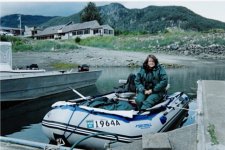doc
Member
- Joined
- Jul 3, 2005
- Messages
- 274
- Reaction score
- 0
- C Dory Year
- 2017
- Vessel Name
- Bella Rey
I just got a call from a friend and fellow veterinarian who took an unanticipated swim in Wrangell Harbor. He was on his boat at the dock and slipped off into the water. As he tells it, he plunged in pretty deep and could not tell up from down. He saw the direction of the bubbles and followed them up. He said he actually went in pretty deep, having a four foot high freeboard and going in head first. There was no one else around to hear his calls for help and he was unable to climb onto the dock. He was able to tie his hands to a cleat so as he says "at least his wife would know what happened". Apparently someone found him tethered there before he died and he woke up in the hospital. His core temp went down to 91F. Three days later, he is pretty exhausted yet, but recovering. Looks like he is a lucky man. Often people suck in a bunch of water due to a shock reflex.
Good time to talk about PFDs. I started wearing mine on the dock when its pretty lonely about or extra hazardous. In the winter when the docks are icy or even in the summer when I am out late at night getting ready for a trip or whatever, anything can happen and it always happens fast. Given the condition of some of our docks around here, it wouldn't be a bad idea to always wear one.
Good time to talk about PFDs. I started wearing mine on the dock when its pretty lonely about or extra hazardous. In the winter when the docks are icy or even in the summer when I am out late at night getting ready for a trip or whatever, anything can happen and it always happens fast. Given the condition of some of our docks around here, it wouldn't be a bad idea to always wear one.




